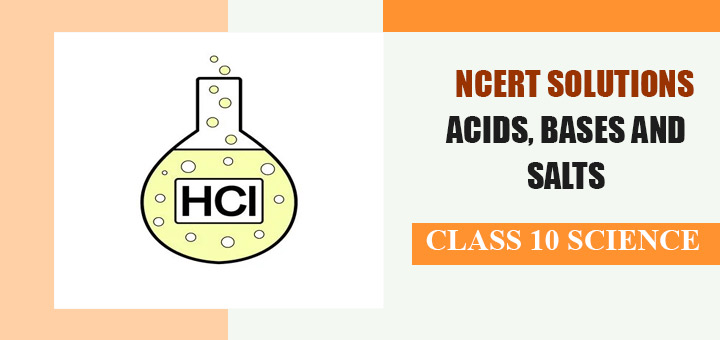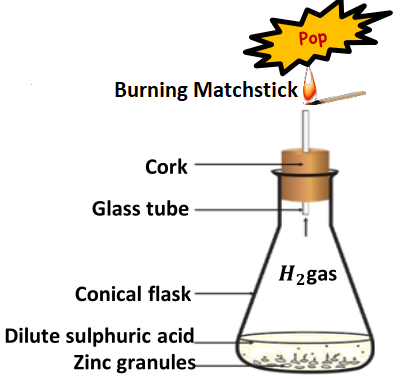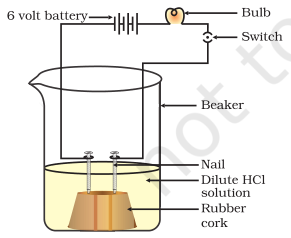NCERT Solutions for Chapter 2 Acids, Bases and Salts Class 10 Science
Book Solutions
Chapter 2 Acids, Bases and Salts NCERT Solutions Class 10 Science
NCERT Solutions for Chapter 2 Acids, Bases and Salts of Class 10 Science Textbook is very helpful chapter. This is very important for the students who are studying in CBSE schools. This chapter will provide the students with the knowledge of acids, bases and salts. It give students basic idea about how the reaction is taking place between acids and salts. Also, it will let the students know about the product formed and catalysts used in the reactions. By studying the NCERT Solutions of this chapter, one could be able to answers the questions related to chemical reactions and equations which could be asked in the examination.
NCERT Solutions for Acids, Bases and Salts Class 10 Science
Chapter Name | NCERT Solutions for Chapter 2 Acids, Bases and Salts |
Subject | Class 10 Science |
Topics covered in the Chapter |
|
Related Readings |
|
These NCERT Solutions of Class 10 NCERT Science Textbook is based on the latest syllabus of CBSE. One could study these questions and answers of acids, bases and salts to give their best shot in the examination. One could also take help from the Revision Notes provided of this chapter to study well. These could be found on the links given in this page.
1
Answer
- Dip the given red litmus paper in each of the three test tubes.
- The solution which turns the red litmus to blue contains basic solution.
- Now, use this blue litmus paper to test the other solutions.
- The tube in which it again changes back to red contains the acidic solution and the tube in which neither red litmus turns blue nor blue litmus turns red contains distilled water.
1
Answer
Curd and other sour substances contain acids which reacts with brass and copper vessels to liberate hydrogen gas and other harmful products which is unfit for consumption.2
Which gas is usually liberated when an acid reacts with a metal? Illustrate with an example. How will you test for the presence of this gas?
Answer
When an acid reacts with a metal, hydrogen gas is usually liberated.

For testing presence of hydrogen gas, we will take few pieces of zinc granules in a test tube and add 5 ml of dilute H2SO4. Now, shake the test tube to mix them. The reaction will be as follows:
H2SO4 + Zn → ZnSO4 + H2 ↑
Pass the gas produced into a soap solution. The bubbles of the soap filled with hydrogen gas will rise up.
Presence of hydrogen gas can be tested by passing this gas (H2) through soap solution. The soap bubbles filled with the gas will rise up. If a burning splinter is brought near the gas, the bubble will burn with a popping sound.
3
Answer
The Metal Compound A is Calcium Carbonate (CaCO3) and the gas produced is CO2. CO2 extinguishes a burning candle.
The balanced chemical equation is:
CaCO3 (s) + 2HCl (aq) → CaCl2 (aq) + CO2 (g) + H2O (l)
Calcium Carbonate + Hydrochloric acid → Calcium Chloride + Carbon dioxide + Water
1
Why do HCl, HNO3, etc., show acidic characters in aqueous solutions while solutions of compounds like alcohol and glucose do not show acidic character?
Answer
HCl or HNO3 show acidic character because when they are mixed with water then they dissolve in water to form H+ or H3O+ ions while when compounds like alcohols and glucose are mixed with water then they do not dissolve to form ions. Hence, they do not show acidic character.
For example:
HCl (aq) → H+ + Cl-
H+ + H2O → H3O+
2
Answer
Aqueous solution of an acid conduct electricity because of the presence of hydrogen (H+) or hydronium (H3O+) ions in the solution.3
Why does dry HCl gas not change the colour of the dry litmus paper?
Answer
Dry HCl gas not change the colour of the dry litmus paper because it has no Hydrogen ions (H+) in it. Hence, it does not show acidic properties and therefore no change takes place in the colour of the dry litmus paper.
4
While diluting an acid, why is it recommended that the acid should be added to water and not water to the acid?
Answer
The process of diluting an acid with water is a highly exothermic process. This is because if water is added into concentrated acid, the heat generated may cause the mixture to splash out and cause burns and the beaker in which it is carried out may break due to excessive heating. Hence, dilution is done by adding acid into water.
5
How is the concentration of hydronium ions (H3O+) affected when a solution of an acid is diluted?
Answer
The concentration of hydronium ions (H3O+) decreases when a solution of an acid is diluted. This means that the strength of the acid decreases.
6
How is the concentration of hydroxide ions (OH−) affected when excess base is dissolved in a solution of sodium hydroxide?
Answer
When excess base is dissolved in a solution of sodium hydroxide, the concentration of OW ions per unit volume increases. This is due to the dissociation of NaOH as well as the other base in the aqueous solution.
1
You have two solutions, A and B. The pH of solution A is 6 and pH of solution B is 8. Which solution has more hydrogen ion concentration? Which of this is acidic and which one is basic?
Answer
As the given pH of solution A is 6 and pH of solution B is 8. Therefore A has more hydrogen ion concentration. Solution A with pH less than 7 is acidic and solution B with pH more than 7 is basic.
2
What effect does the concentration of H+(aq) ions have on the nature of the solution?
Answer
If the concentration of H+ (aq) ions is increased (>10-7) then the solution become acidic and if the concentration of H+ (aq) ions is decreased (<10-7) then the solution become basic in nature. Acidic nature of the solution increases on increasing the concentration of H+ ions.
3
Do basic solutions also have H+ (aq) ions? If yes, then why are these basic?
Answer
Yes, Basic solutions also contain H+ (aq) ions. However, their concentration is less as compared to the concentration of OH- ions that makes the solution basic. Since, [OH- (aq)] is more than [H+ (aq)] hence these are basic solutions.
4
Under what soil condition do you think a farmer would treat the soil of his fields with quick lime (calcium oxide) or slaked lime (calcium hydroxide) or chalk (calcium carbonate)?
Answer
If the pH of the soil is less than 7, i.e. it is acidic; the farmer will treat the soil with alkaline substances like quick lime, slaked lime, and chalk. For healthy growth of plants, the soil should neither be alkaline nor highly acidic.
1
What is the common name of the compound CaOCl2?
Answer
The common name of the compound CaOCl2 is Bleaching Powder.
2
Name the substance which on treatment with chlorine yields bleaching powder?
Answer
The substance which yields bleaching powder on treatment with chlorine is Calcium hydroxide [Ca(OH)2] (dry slaked lime).
3
Name the sodium compound which is used for softening hard water.
Answer
Washing soda (Na2CO3.10H2O)4
What will happen if a solution of sodium hydrocarbonate is heated? Give the equation of the reaction involved.
Answer
When a solution of sodium hydrocarbonate (sodium hydrogencarbonate) is heated, sodium carbonate and water are formed with the evolution of carbon dioxide gas.
2NaHCO3 + heat → Na2CO3 + H2 O + CO2
5
Answer
1
(a) 1
(b) 4
(c) 5
(d) 10
Answer
The correct option is (d) 10.2
A solution reacts with crushed egg-shells to give a gas that turns lime-water milky. The solution contains
(a) NaCl
(b) HCl
(c) LiCl
(d) KCl
Answer
The correct option is (b) HCl.Egg shells is made up of calcium carbonate i.e. CaCO3
which on reaction with HCl liberates CO2
gas which turn lime water to milky.
CaCO3 + HCl → CaCl2 + H2O +
CO2
3
10 mL of a solution of NaOH is found to be completely neutralised by 8 mL of a given solution of HCl. If we take 20 mL of the same solution of NaOH, the amount of HCl solution (the same solution as before) required to neutralise it will be
(a) 4 mL
(b) 8mL
(c) 12 mL
(d) 16 mL
Answer
The correct option is (d) 16 mL.4
(a) Antibiotic
(b) Analgesic
(c) Antacid
(d) Antiseptic
Answer
The correct option is (c) Antacid5
(a) dilute sulphuric acid reacts with zinc granules.
(b) dilute hydrochloric acid reacts with magnesium ribbon.
(c) dilute sulphuric acid reacts with aluminium powder.
(d) dilute hydrochloric acid reacts with iron filings.
Answer
(a) H2SO4 (aq) + Zn (s) → ZnSO4 (aq) + H2 (g)(b) 2HCl (aq) + Mg (s) → MgCl2 (aq) + H2 (g)
(c) 3H2SO4 (aq) + 2Al (s) → Al2(SO4)3 (aq) + 3H2 (g)
(d) 6HCl (aq) + 2Fe (s) → 2FeCl3 (aq) + 3H2 (g)
6
Answer
- Fix two nails on a cork and place it in a 100 mL beaker.
- Connect these nails to a 6 volt battery through a bulb and switch as shown in the figure.
- Pour some aqueous solution of alcohol or aqueous solution of glucose in the beaker so that nails dip in it.
- Switch on the current.

HCl dissociates into H+and Cl−ions. These ions conduct electricity in the solution resulting in the glowing of the bulb. On the other hand, the glucose solution does not dissociate into ions. Therefore, it does not conduct electricity.
From this activity, it can be concluded that all acids contain hydrogen but not all compounds containing hydrogen are acids.
That is why, though alcohols and glucose contain hydrogen, they are not categorised as acids.
7
Why does distilled water not conduct electricity, whereas rain water does?
Answer
Distilled water does not conduct electricity because it does not contain any ions. Rainwater contains ions due to dissolved salts, hence it conducts electricity.
8
Why do acids not show acidic behaviour in the absence of water?
Answer
Acids do not show acidic behaviour in the absence of water because in the absence of water, acids do not dissociate to give hydrogen ions.
9
Five solutions A, B, C, D and E when tested with universal indicator showed pH as 4, 1, 11, 7 and 9, respectively. Which solution is
(a) neutral?
(b) strongly alkaline?
(c) strongly acidic?
(d) weakly acidic?
(e) weakly alkaline?
Arrange the pH in increasing order of hydrogen-ion concentration
Answer
Arrange the pH in increasing order of hydrogen-ion concentration.
|
Solution |
pH |
Nature of the solution |
|
A |
4 |
Weakly acidic |
|
B |
1 |
Strongly acidic |
|
C |
11 |
Strongly alkaline |
|
D |
7 |
Neutral |
|
E |
9 |
Weakly alkaline |
The increasing order of hydrogen-ion concentration is: 11 < 9 < 7 < 4 < 1 (pH values).
10
Equal lengths of magnesium ribbons are taken in test tubes A and B. Hydrochloric acid (HCl) is added to test tube A, while acetic acid (CH3COOH) is added to test tube B. In which test tube will the fizzing occur more vigorously and why?
Answer
Fizzing occurs more vigorously in test tube A as compared to in test tube B. This is because concentration of hydrogen ion is more in test tube A than in test tube B as hydrochloric acid is a strong acid and acetic acid (CH3COOH) is a weak acid.
11
Fresh milk has a pH of 6. How do you think the pH will change as it turns into curd? Explain your answer.
Answer
As the milk turns into curd its pH will decrease due to the production of lactic acid which is acidic in nature.
12
A milkman adds a very small amount of baking soda to fresh milk.
(a) Why does he shift the pH of the fresh milk from 6 to slightly alkaline?
(b) Why does this milk take a long time to set as curd?
Answer
(a) Fresh milk is acidic in nature. On addition of very small amount of baking soda, milk becomes alkaline and does not turn sour easily.
(b) This milk takes a long time to set as curd because the presence of alkali does not allow it to become more acidic.
13
Plaster of Paris should be stored in a moisture-proof container. Explain why?
Answer
Plaster of Paris gains moisture and sets into a hard mass known as gypsum. Therefore it must be stored in a moisture-proof container.

14
Answer
A reaction in which an acid and base react with each other to give a salt and water is termed as neutralization reaction.
Or,
It is a reaction of an acid with a base to form a salt and water.
For Example:

15
Give two important uses of washing soda and baking soda.
Answer
(a) Uses of washing soda:
- It is used in the manufacture of glass and soap.
- It is used in the manufacture of borax.
(b) Uses of baking soda:
- It is used in soda-acid fire extinguisher.
- It is used for making baking powder.
Above mentioned NCERT Solutions for Chapter 2 Acids, Bases and Salts is very important for the students who want to get good marks in the examination. They can study those NCERT Solutions in order to excel in Science subject. We have also provided solutions of different chapter of Class 10 Science Textbook published by NCERT.
NCERT Textbooks Solutions for Class 10 Science
Chapter 1 Chemical Reactions and Equations |
Chapter 3 Metals and Non-metals |
Chapter 4 Carbon and its Compounds |
Chapter 5 Periodic Classification of Elements |
Chapter 6 Life Processes |
Chapter 7 Control and Coordination |
Chapter 8 How do Organisms Reproduce? |
Chapter 9 Heredity and Evolution |
Chapter 10 Light – Reflection and Refraction |
Chapter 11 The Human Eye and the Colourful World |
Chapter 12 Electricity |
Chapter 13 Magnetic Effects of Electric Current |
Chapter 14 Sources of Energy |
Chapter 15 Our Environment |
Chapter 16 Sustainable Management of Natural Resources |
Students can click on the above link to access the chapter solutions of those chapters. These NCERT Solutions are as per the latest syllabus prescribed by CBSE. Also, it enhance the ability of a child to study more efficiently and in a better way. Students can also access to important questions and answers of Chapter 2 Acids, Bases and Salts provided by this website. These are also very important in examination.
There are various types of questions that could be asked in the examination which includes short answer type questions (SAQ), multiple choice questions (MCQ), Long Answer Type questions (LAQ), Activity based questions and Practical Based Questions. Students must aware of all these types of questions and practice according to it.